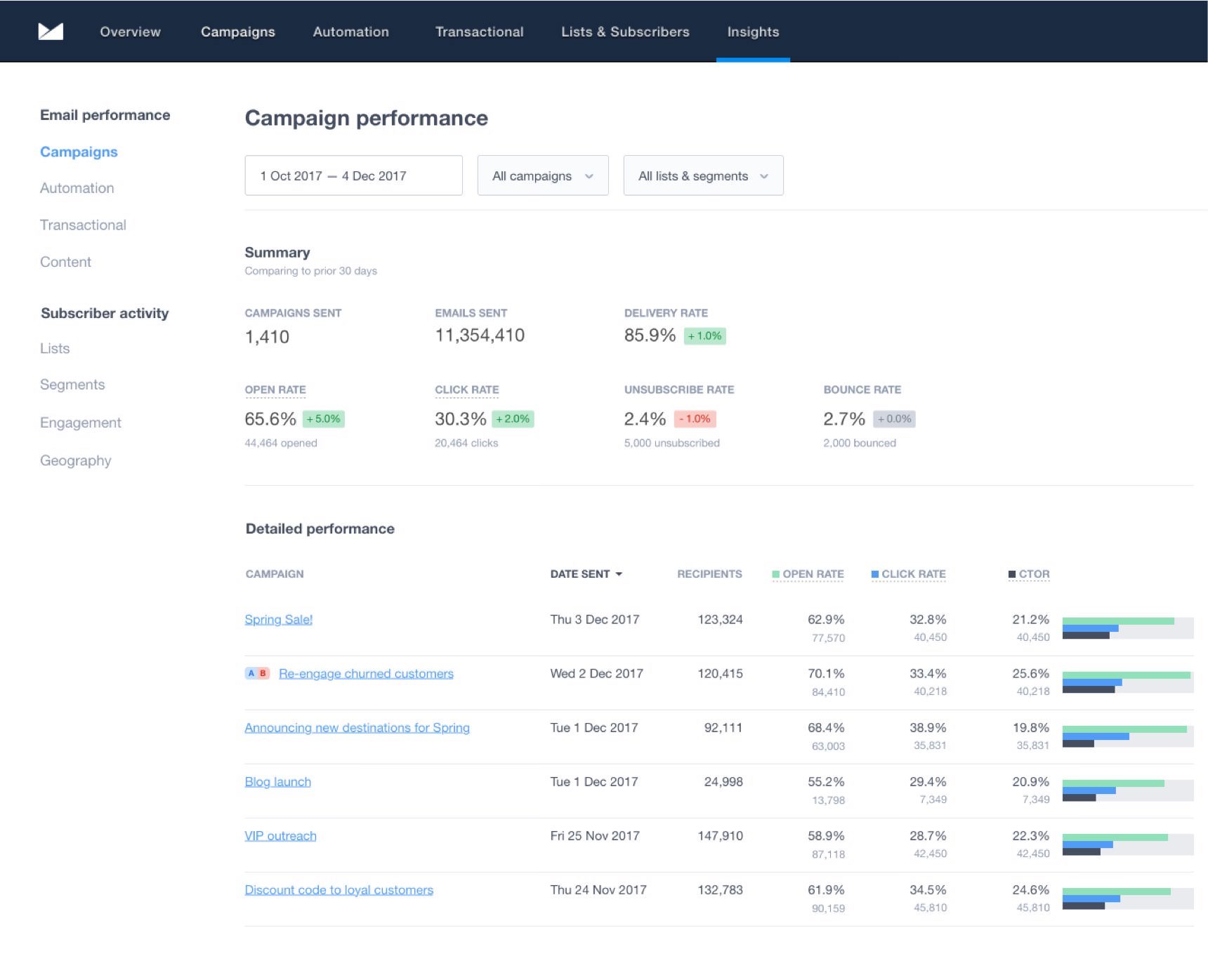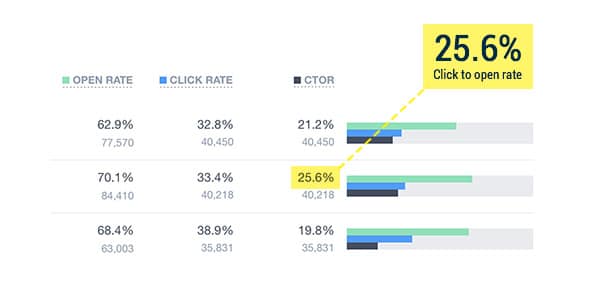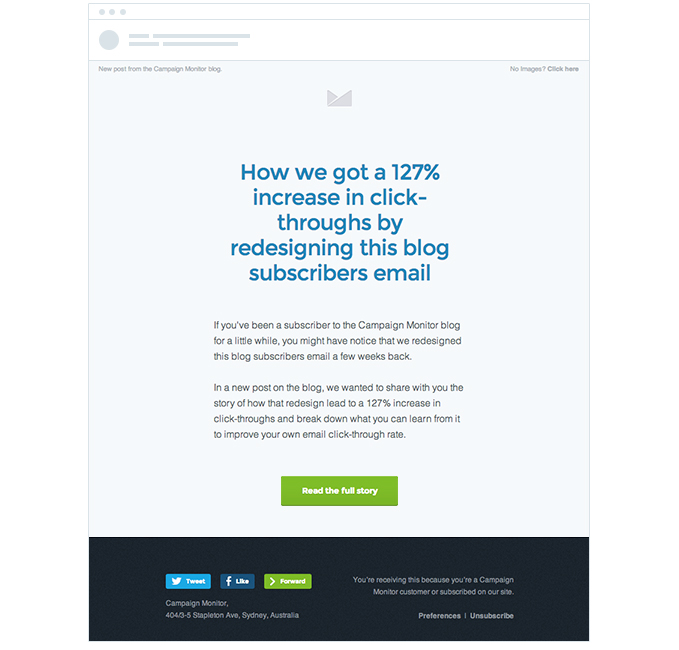This post has been updated as of May 2019.
Are you unhappy with the click-through rates of your email campaigns?
You’re writing great copy and using beautiful images, but for some reason, your click-through rates are lower than you’d like them to be.
The problem could be the calls to action you’re using.
With our email builder Canvas, it’s super easy to add call to action (CTA) buttons anywhere in your email.
Do buttons increase click-through rates?
With so many tools available to marketers to help create buttons for CTAs, is it really worth the time and effort when it comes to trying to increase your overall click-through rates?
Before diving into that answer, it’s vital to have a solid understanding of what a click-through rate is, why it matters, and how to figure out what your click-through rate is.
What is a click-through rate and why does it matter?
A click-through rate is a valuable key performance indicator (KPI) that helps your marketing team decipher who’s taking action when you send out an email or email campaign to your subscribers. More specifically, it tells you how many people are clicking on a hyperlink, CTA, or image within a particular email.

Source: Campaign Monitor
What is the average click-through rate?
Once you’ve figured out your average click-through rate, you’ll probably want to know how you stack up against your competition.
As of December 2018, the average overall CTR for all industries was 7.06%
Another metric that can be compared to the click-through rate is the click-to-open rate. The click-to-open rate differs slightly in that this metric counts the unique clicks (clicks from a single user), while the click-through rate can include multiple clicks by the same source.

Source: Campaign Monitor
For the average email, click-to-open rate falls at about 14.10%
So are email buttons worth it? Do they really improve click-through rates over using standard text links? Let’s investigate.
How do you determine your click-through rate?
While many marketing tools provide users with analytics to help them monitor KPIs, there’s a simple way to figure your click-through rate on your own.
To find your click-through rate, simply take your number of clicks your email received and divide it by the number of times your email was opened. Finally, take this number and multiply it by 100 to get the actual percentage rate.
Now, if you’re more concerned with your click-to-open rate, you take your equations and change out a few numbers. Instead of using the total numbers of clicks your emails received, you want to use the number of unique clicks.
From there, the formula remains pretty much the same: Take the number of unique clicks and divide it by the number of opened emails. Finally, take this number and multiply it by 100 to get the percentage rate.
We tested the effects of using a link vs. an HTML email button—here’s what we learned
At Campaign Monitor we’re huge fans of A/B testing—it increases the click-through rate of our own email campaigns and enables us to share what we learned with you! So we decided to test using a link vs. a button as the main call to action in one of our recent campaigns to figure out which works best.
Here’s the version of our email with the CTA as a link at the bottom:

And here’s the version of our email with the CTA as a button at the bottom:
The result?
Using a call-to-action button instead of just a text link got us a 28% increase in click-throughs.
We’ve also seen other results that further support the effectiveness of buttons over linked text. For instance, we received a 127% increase in click-throughs when we redesigned our blog subscribers email a few months ago, and the addition of a button over a text link was a significant contributor to this.
Why buttons increase click-through rates
So why do buttons increase click-through rates? Both the button and the link have the same copy and offer the same end result, so why such a big difference?
Research shows most people scan email campaigns rather than reading them word for word, so using buttons for your call to action means they’ll stand out to skimmers, while text links will often go overlooked.
This is because buttons have a number of unique attributes linked text doesn’t, including:
- Size – Oftentimes, a button will be much larger in size than a linked piece of text, catching the skimmer’s eye.
- Design – Buttons often have design elements that links don’t, such as shadows, gradients, and other effects. This can make them “pop” off the page and stand out to skimmers.
- Color – Often, buttons will have a different color from the background and text, and this contrast draws the eye and makes the reader notice them more.
- Whitespace – When a button is set away from other elements in the email, the whitespace around it creates an area free from distraction, leading the reader right to it.
Using a button for your call to action draws significantly more attention to it, making it easier for a reader to take the conversion action and ultimately resulting in an increased number of people doing so.
How do you add a button to an email?
Now that it’s clear how CTA buttons can help improve your conversion rates, it’s time to incorporate some into an email campaign of your own. Unfortunately, many email clients opt to block images by default, so creating your button as an image isn’t always the best idea when trying to learn how to create a button in HTML.
How do I create a hyperlink button?
If you’re using Canvas, you can easily add beautiful buttons that work across all devices and email clients by simply dragging and dropping the button wherever you need it. This is especially ideal for those who are wondering how to center a button in HTML and have little knowledge in coding and the language involved.
Alternatively, you can use the Bulletproof Button Tool to create customized buttons that’ll work across all devices and clients. You simply select the options you want, enter the text for your button, and then copy and paste the code into whatever email tool you’re using.
Wrap up
Using buttons for your calls to action can help increase the click-through rate of your email campaigns, and tools like Canvas and Bulletproof Buttons make it simple to get started.
So, give it a try—test a link vs. a button in your next email campaign and let us know if you saw a difference. Just make sure to get your microcopy right.
Need a little extra guidance on how to improve your click-through rate by using quality microcopy? Let Campaign Monitor help.





